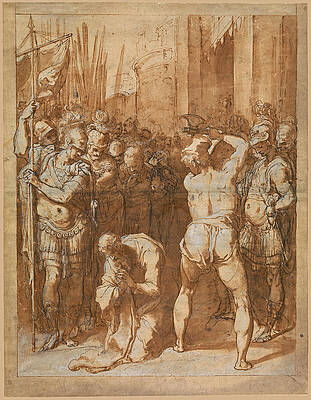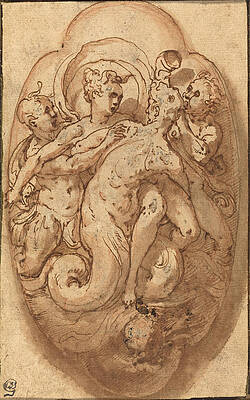Taddeo Zuccari, Taddeo Zuccaro
Paintings



Palazzo Faranese: Farnesiani Fasti

Palazzo Faranese: Farnesiani Fasti
Drawings
Jonah and the Whale seen from a Landscape with Trees
The Martyrdom of Saint Paul
Group of Six Reclining Nude Women. Nymphs Bathing
Saint Paul Restoring Eutychus to Life
Alexander the Great and Bucephalus
Mythological Figures


Taddeo Zuccari (or Zuccaro) (1 September 1529 – 2 September 1566) was an Italian painter, one of the most popular members of the Roman mannerist school.
Biography
Zuccari was born in Sant'Angelo in Vado, near Urbino, the son of Ottaviano Zuccari, an almost unknown painter. His brother Federico, born around 1540, was also a painter and architect.
Zuccari moved to Rome by age 14, and he succeeded at an early age in gaining a knowledge of painting and in finding patrons to employ him. When he was seventeen a pupil of Correggio, named Daniele da Parma, engaged him to assist in painting a series of frescoes in a chapel at Vitto near Sora, on the borders of the Abruzzi (not corroborated by Freedberg). Zuccari returned to Rome in 1548, and began his career as a fresco painter, by executing a series of scenes in monochrome from the life of Marcus Furius Camillus on the front of the palace of a wealthy Roman named Jacopo Mattei. From that time his success was assured, and he was largely employed by the popes Julius III and Paul IV, by the della Rovere duke of Urbino, and by other rich patrons.[1] He is documented to have worked alongside Prospero Fontana in decorating the Villa Giulia. In 1556, he painted frescoed Scenes of the Passion in the "Cappella Mattei" of Santa Maria della Consolazione.
His best frescoes were a historical series in quadro reportati painted on the walls and ceiling of Villa Farnese at Caprarola, built for Cardinal Alessandro Farnese, for which Zuccari also designed a great quantity of rich decorations in stucco relief after the style of Giulio Romano and other pupils of Raphael.[1] He also painted Histories of Alexander in the Castello Orsini at Bracciano. Nearly all his paintings were large, rapidly executed frescos, often in chiaroscuro or monochrome. Stylistically, he also displays a Mannerist taste for sculpted physicality characteristic of Michelangelo.[2] Vasari praised his compositional skill and the refined fluidity and vigour of his style, singling out his treatment of heads, hands and nudes.[2]
Zuccari's easel pictures are less common than his decorative frescoes. A small painting on copper of the Adoration of the Shepherds, formerly in the collection of James II, is now at Hampton Court Palace. The Caprarola frescoes were engraved and published by Prenner, Illustri Fatti Farnesiani Coloriti nel Real Palazzo di Caprarola (Rome, 1748–50).[1]
He painted Conversion of St. Paul in San Marcello al Corso in Rome.
He died in Rome in 1566, and was buried in the Pantheon, not far from Raphael.[1]
References
Public Domain One or more of the preceding sentences incorporates text from a publication now in the public domain: Middleton, John Henry (1911). "Zuccaro". In Chisholm, Hugh. Encyclopædia Britannica 28 (11th ed.). Cambridge University Press. p. 1047.
Cheney, Liana De Girolami. "Zuccaro". Oxford Art Online. Oxford University Press. (subscription required)
Freedberg, Sydney J. (1993). Pelican History of Art, ed. Painting in Italy, 1500-1600. Penguin Books Ltd. pp. 490–495.
---
Fine Art Prints | Greeting Cards | Phone Cases | Lifestyle | Face Masks | Men's , Women' Apparel | Home Decor | jigsaw puzzles | Notebooks | Tapestries | ...
---
Artist
A - B - C - D - E - F - G - H - I - J - K - L - M -
N - O - P - Q - R - S - T - U - V - W - X - Y - Z
Retrieved from "http://en.wikipedia.org/"
All text is available under the terms of the GNU Free Documentation License








